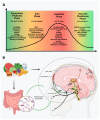All Roads Lead to the Gut: The Importance of the Microbiota and Diet in Migraine
- PMID: 37755364
- PMCID: PMC10536453
- DOI: 10.3390/neurolint15030073
All Roads Lead to the Gut: The Importance of the Microbiota and Diet in Migraine
Abstract
Migraine, a prevalent neurological condition and the third most common disease globally, places a significant economic burden on society. Despite extensive research efforts, the precise underlying mechanism of the disease remains incompletely comprehended. Nevertheless, it is established that the activation and sensitization of the trigeminal system are crucial during migraine attacks, and specific substances have been recognized for their distinct involvement in the pathomechanism of migraine. Recently, an expanding body of data indicates that migraine attacks can be prevented and treated through dietary means. It is important to highlight that the various diets available pose risks for patients without professional guidance. This comprehensive overview explores the connection between migraine, the gut microbiome, and gastrointestinal disorders. It provides insight into migraine-triggering foods, and discusses potential diets to help reduce the frequency and severity of migraine attacks. Additionally, it delves into the benefits of using pre- and probiotics as adjunctive therapy in migraine treatment.
Keywords: dietary triggers; diets; gut microbiome; gut-bran axis; headache; migraine; nutrition; prebiotics; probiotics.
Conflict of interest statement
We cannot identify any commercial or financial relationships that could be construed as potential conflict of interest.
Figures





References
-
- GBD 2016 Disease and Injury Incidence and Prevalence Collaborators Global, regional, and national incidence, prevalence, and years lived with disability for 328 diseases and injuries for 195 countries, 1990–2016: A systematic analysis for the Global Burden of Disease Study 2016. Lancet. 2017;390:1211–1259. doi: 10.1016/S0140-6736(17)32154-2. - DOI - PMC - PubMed
-
- Al Ghadeer H.A., AlSalman S.A., Albaqshi F.M., Alsuliman S.R., Alsowailem F.A., Albusror H.A., AlAbdi Z.I., Alwabari E.M., Alturaifi Z.A., AlHajji A.M. Quality of Life and Disability Among Migraine Patients: A Single-Center Study in AlAhsa, Saudi Arabia. Cureus. 2021;13:e19210. doi: 10.7759/cureus.19210. - DOI - PMC - PubMed
Publication types
Grants and funding
LinkOut - more resources
Full Text Sources

